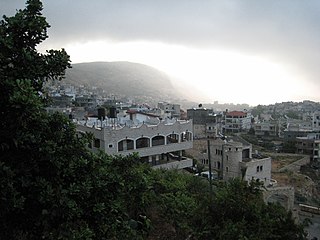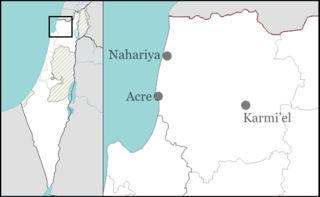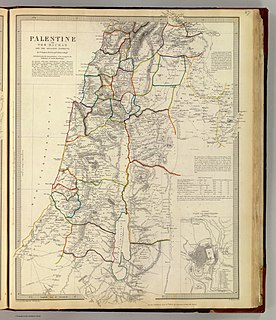See also
- Shagur, a wind instrument
| This disambiguation page lists articles about distinct geographical locations with the same name. If an internal link led you here, you may wish to change the link to point directly to the intended article. |
Shaghur could refer to the following places:
| This disambiguation page lists articles about distinct geographical locations with the same name. If an internal link led you here, you may wish to change the link to point directly to the intended article. |

Damascus is the capital of Syria; it is also the country's largest city, following the decline in population of Aleppo due to the battle for the city. It is colloquially known in Syria as aš-Šām (الشام) and titled the "City of Jasmine". Damascus is a major cultural center of the Levant and the Arab world. The city has an estimated population of 1,711,000 as of 2009.

Galilee is a region mainly located in northern Israel. The term Galilee traditionally refers to the mountainous part, divided into Upper Galilee and Lower Galilee.

Via Maris is one modern name for an ancient trade route, dating from the early Bronze Age, linking Egypt with the northern empires of Syria, Anatolia and Mesopotamia — along the Mediterranean coast of modern-day Egypt, Palestine, Israel, Iran, Iraq, Turkey and Syria. In Latin, Via Maris means "way of the sea", a translation of the Greek ὁδὸν θαλάσσης found in Isaiah 9:1 of the Septuagint. It is a historic road that runs in part along the Israeli Mediterranean coast. It was the most important route from Egypt to Syria which followed the coastal plain before crossing over into the plain of Jezreel and the Jordan valley.

The Nimrod Fortress or Nimrod Castle is a medieval Ayyubid castle situated on the southern slopes of Mount Hermon, on a ridge rising about 800 m above sea level. It overlooks the Golan Heights and was built with the purpose of guarding a major access route to Damascus against armies coming from the west.

The Barada is the main river of Damascus, the capital city of Syria.

Deir al-Asad is an Arab town in the Galilee region of Israel, near Karmiel. Together with the adjacent town of Bi'ina it formed the site of the Crusader monastery town of St. George de la Beyne, an administrative center of the eponymous fief which spanned part of the central Galilee. Control of the fief changed several times from the noble Milly family to Joscelyn III of Courtenay and ultimately to the Teutonic Order before the area passed to Mamluk rule in the late 13th century. Settlement continued under the Mamluks and the village's St. George monastery was mentioned as treating the mentally ill in the late 14th century. The modern Muslim town of Deir al-Asad, previously known as Deir al-Bi'ina or Deir al-Khidr, was established in 1516 when the Ottoman sultan Selim I granted its monastery as a waqf to the Sufi sage Shaykh Muhammad al-Asad, who settled in it with his family and devotees. The village's original Christian population was expelled by the same order and relocated to Bi'ina, while a Druze community which established itself in the town emigrated to the Hauran by the late 1870s.

Shaghur or Shagor was an Arab city in the Northern District of Israel located east of the coastal city of Acre (Akka). It was formed in 2003 with the merger of three Arab local councils – Majd al-Krum, Deir al-Asad and Bi'ina. It was declared a city in 2005. The city was dissolved on December 1, 2008 by Knesset decree and the pre-2003 component villages were given independent standing. It is the third largest Arab locality in the Northern District after Nazareth and Shefa-'Amr. The name Shaghur comes from the name of the nearby valley which borders the al-Araas mountain in which the city is built upon. The city had a population of 29,900 at the end of 2007.

Majd al-Krum is an Arab town located in the Galilee in Israel's Northern District about 16 kilometers east of Acre. The name of the village translates to "watch-house of the vineyard", reflecting the town's fame for the quality of its grape vines. The town is entirely inhabited by Muslims. In 2018 it had a population of 15,292.

Arraba, also known as 'Arrabat al-Battuf, is an Arab city in Israel. It is located in the Lower Galilee in the Northern District, within Sakhnin valley, adjacent to Sakhnin and Deir Hanna, and climbing a bit on Yodfat range to its south, while also owning some lands south of that in the Beit Netofa Valley to the north of Nazareth area. Arraba attained local council status in 1965, and city status in 2016. In 2018 its population was 25,369.

The Jezreel Valley railway, or the Valley Train was a railroad that existed in Ottoman and British Palestine, reconstituted as a modern railway in Israel in the 21st century. It runs from the Mediterranean coast inland along the length of the Jezreel Valley. The historical line was a segment of the longer Haifa–Dera'a Line, which was itself a branch of the larger Hejaz railway.
The Israeli municipality merger of November 2003 was a merger of various select municipalities under the Israeli system of local governance.

Jamraya or Jemraya is a village in the Qudsaya District of Rif Dimashq in southern Syria. It lies 3 miles (5 km) to the northwest of the Syrian capital of Damascus city, beyond Mount Qasioun, and is now an outlying suburb of greater Damascus. It is between al-Hamah and Qudsaya town to the south, and Ashrafiyat al-Wadi to the north. It is about 10 miles (15 km) from the Lebanese border. According to the Syria Central Bureau of Statistics, the village had a population of 1,156 in the 2004 census.
Beit HaKerem Valley, also known as al-Shaghur, is a valley in the Galilee region in northern Israel.

Several incidents have taken place on the Israeli–Syrian ceasefire line during the Syrian Civil War, straining the relations between the countries. The incidents are considered a spillover of the Quneitra Governorate clashes since 2012 and later incidents between Syrian Army and the rebels, ongoing on the Syrian-controlled side of the Golan and the Golan Neutral Zone and the Hezbollah involvement in the Syrian Civil War. Through the incidents, which began in late 2012, as of mid-2014, one Israeli civilian was killed and at least 4 soldiers wounded; on the Syrian-controlled side, it is estimated that at least ten soldiers were killed, as well as two unidentified militants, who were identified near Ein Zivan on Golan Heights.

Safad Sanjak was a sanjak (district) of Damascus Eyalet in 1517–1660, after which it became part of the Sidon Eyalet. The sanjak was centered in Safed and spanned the Galilee, Jabal Amil and the coastal cities of Acre and Tyre. The city of Safed was made up of Muslim and Jewish townspeople, while the rest of the sanjak was populated by Sunni Muslim peasants and Bedouin tribesmen, and Shia Muslim and Druze peasants.
The following is a timeline of the Syrian Civil War from January to April 2017. Information about aggregated casualty counts is found at Casualties of the Syrian Civil War.

The Beit Jinn offensive was a military operation by the Syrian Arab Army against opposition groups in the Western Ghouta area, starting on 28 November 2017.

Samad is a village in southern Syria, administratively part of the Daraa Governorate, located east of Daraa and immediately southeast of Bosra. Other nearby localities include al-Qurayya to the northeast, Hout to the east and Dhibin to the southeast. According to the Syria Central Bureau of Statistics (CBS), Samad had a population of 3,098 in the 2004 census.
Iran–Israel conflict during the Syrian Civil War refers to the Iranian-Israeli standoff in and around Syria on the course of the Syrian conflict. With increasing Iranian involvement in Syria from 2011 onwards, the conflict shifted from a proxy war into a direct confrontation by early 2018.